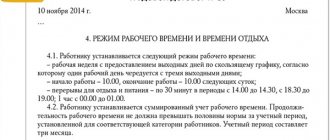Home / Labor Law / Employment / Hiring
Back
Published: 06/21/2016
Reading time: 11 min
0
982
The procedure for employing an employee is accompanied by the need to complete many documents. Some of them, approved by law, are provided by the employee himself, the rest must be prepared by the employer.
It is worth considering in more detail what stages the procedure for employing an employee consists of, what documents he must provide, and also what the responsibilities of the future manager are.
- Legislation
- Preparatory stage: necessary documents and their verification
- Main stage: interviewing and concluding an employment contract
- Final stage: paperwork and permission to work Issue an order for employment
- Make an entry in the work book
- Familiarize the employee with regulations
- Issue a personal card for the employee
- Create a personal file
- Conduct the necessary instructions
Hiring procedure: what documents are regulated?
When employing new employees, the employer should be guided by the norms of labor legislation. Deviation from them is classified as a violation of the law, entailing administrative or criminal liability.
Table: regulatory documents governing the hiring procedure
| Title of the document | Characteristic |
| Labor Code of the Russian Federation | He dwells in detail on the procedure for preparing employment contracts and books (chapters 10 and 11). Lists the documents submitted when concluding an employment contract (Article 65). Indicates how to correctly draw up and maintain work books for hired workers (Article 66). |
| Government Decree No. 225 of April 16, 2003, as amended on May 19, 2008, and the Ministry of Labor No. 69 of October 10, 2003. | These documents establish the order in which work books are filled out, how they are recorded and stored in the organization. |
| Resolution No. 1 of 01/05/2004 of the State Statistics Committee (Goskomstat) | Provides samples of documents relevant for employment (employment order, personal card, etc.). |
What documents are requested when applying for a job?
A citizen must be prepared for the fact that when applying for employment he will have to present the following documents:
- Passport or other identification document (birth certificate, passport of your country and permission to stay in Russia for people from other countries, etc.).
- Work record book (if this is the first employment, it is created by this organization).
- Insurance certificate of pension insurance.
- Military registration documents (for those liable for military service or conscripts).
- Diploma of education (if the job requires special training and knowledge).
- Medical certificate (if minors are hired or if this is work in the catering industry).
- Certificate of assignment of TIN.
SNILS is one of the necessary documents presented by a future employee when concluding an employment contract (Article 65 of the Labor Code of the Russian Federation)
Sometimes additional documents are requested.
When applying for a state or municipal service, the applicant is given a questionnaire, which he undertakes to fill out.
In addition to submitting the main package of documents, a potential employee, upon entering the service of state or municipal bodies, must fill out a questionnaire
Criteria for employees
The employer can put forward any criteria, it all depends on personal wishes and his professionalism. Sometimes, they look for girls with pleasant appearance for the position of secretary, but they don’t write about this on the advertisement (after all, this is prohibited), but during the interview they pay considerable attention to this factor.
If an employee is ideally suited for the proposed position, but the employer can give a compelling reason for his refusal, then this will be completely legal. But, in the case of direct discrimination on any grounds, you can safely challenge such a decision.
Qualities employers want to see
- Neat appearance (few people will like an applicant for the position of accountant who looks more like a schoolboy rather than an experienced person).
- Decent behavior (no chewing gum; no one likes someone who mumbles or jostles in a line of
- applicants). Culture of communication (swearing, vernacular, old woman’s sayings are not appropriate).
- Confidence in your actions and yourself (answer all questions clearly, thoughtfully, be able to express your opinion briefly but clearly).
- Availability of references from previous places of work.
- Availability of work in one or another field of activity (accounting experience, work with documents, office work, computer knowledge).
- Sufficient educational level (some positions require higher education).
- Proficiency in a profession (professionalism).
Similar posts on the topic:
- How to fill out a job application form
- Logic tests when applying for a job
- Letter of guarantee for employment
- Requirements for a driver when hiring, is an internship required?
Procedure and rules for applying for a job according to the Labor Code of the Russian Federation
When hiring new people, a certain sequence of actions is followed. They relate to the collection of documentation requested from citizens and its study, the issuance of an order for employment, the execution and signing of an employment contract.
Acceptance of necessary documents from the employee
In addition to the package of documents described above, the applicant submits an application for employment. It is worth mentioning right away that according to the law it is not necessary to write it. In the Labor Code of the Russian Federation (Article 65), the application is not mentioned in the list of documents required for employment. However, in some cases (for example, when entering the civil service), it is drawn up and submitted along with the main documentation. The employer accepts the necessary package of documents for authentication. Photocopies are made of some of them (passports, SNILS, TIN) or data is copied (military ID), and the originals are returned to the owner (except for the work book).
After checking the documents, the employer decides whether to hire a potential employee or refuse to employ him.
As for the job application, it is drawn up arbitrarily, since there is no established template. However, its content must meet certain requirements (a sample form is here). It is issued in the name of the first person of the organization.
The text of the application contains the following data:
- Full name of the potential employee;
- the name of the structural unit (if any) and the position (profession) in which the citizen plans to work;
- salary for the position held according to the staffing table;
- the date from which the citizen plans to begin his activities with this employer;
- information about familiarization with internal labor regulations;
- date of writing.
A job application is written in free form, but sometimes large organizations develop their own unified forms
Familiarization of the employee with internal documents
A citizen who has begun to fulfill his duties receives a number of local regulations for review.
Local regulations are internal documents of an organization or company adopted by management that contain rules of conduct for employees.
List of local regulations that an employee must study:
- internal labor regulations (sample here);
- job description;
- labor protection instructions;
- regulations on the structural unit in which the employee will perform his job duties;
- regulations on certification;
- provisions on trade secrets;
- wage regulations;
- schedule;
- shift schedule;
- rules for storing and using employee personal data.
The shift schedule is one of the local regulations of the organization, with which the employee can be familiarized
Labor legislation does not regulate the procedure for familiarizing employees with internal documentation. The employer has the right to use any method for this purpose, but the employee must sign after such a procedure.
Do not forget that failure to familiarize employees with the internal documents of the organization is illegal and entails administrative liability for the employer.
Table: ways to familiarize employees with internal documentation
| Method of introduction | Characteristic |
| Signature of the employed person on the familiarization sheet | The employee's full name and date of acquaintance are indicated here. This sheet is attached to each local regulatory act, numbered, stitched and sealed and signed by the official. |
| Signature of the employed person in a special journal for familiarizing employees with local regulations | Unlike a familiarization sheet, this log may provide the opportunity for employees to familiarize themselves with several local regulations. |
| The employee’s signature on the familiarization sheet, which is an appendix to the employment contract | All local regulations with which the employee is familiar are listed here. |
How to draw up an employment contract correctly
An employment contract is a document that fixes the rights and obligations of the employee and the employer.
The employment contract comes into force after it is signed by the employee and the employer. The citizen begins to perform his duties on the date specified in the employment contract. If the day is not specified, then this occurs after the contract has entered into force.
In order to correctly draw up such an important document, it would be useful to refer to the law. In Art. 57 of the Labor Code of the Russian Federation names information and conditions that in any case should be reflected in the text of the employment contract:
- Full name of the applicant and the name of his place of employment;
- information about identification documents of the employee and the employer (if he is an individual);
- TIN (for employers, with the exception of individual employers who are not individual entrepreneurs);
- information about the representative of the employer who signed this document, as well as the basis by which he is vested with such powers;
- place and date of conclusion of the employment contract.
Table: contents of the employment contract
| Terms of the employment contract | What are they characterized by? |
| Place of work | The employment contract must define the place of work, indicating the structural unit and its location. If the work has a traveling nature, this is also indicated. |
| Labor function | The employee’s labor function is determined, i.e., what position he has (profession, specialty) in accordance with the staffing table with clarification of qualifications. |
| Start date | The start date of work must be indicated, and for a fixed-term employment contract, the validity period and the circumstances that served as the basis for its conclusion. |
| Terms of payment | The specific size of the employee's tariff rate or salary, additional payments, allowances, and incentive payments is indicated. |
| Mode | A specific working time and rest time regime is indicated if for a given employee it differs from the general rules. |
| Compensation | The amount of compensation for hard work and work under harmful or dangerous working conditions is indicated. |
| Condition on compulsory social insurance | This condition reflects the fact that from the moment the employment contract is concluded, the employee becomes insured, and in the event of illness, pregnancy or injury, he has the right to receive insurance payments. |
| Other conditions | The contract may also include other conditions that are mandatory in certain cases. |
If an employee’s responsibilities include working in hazardous conditions, the employment contract specifies the amount of compensation for such a risk.
Preparation of an employment order
An order or instruction for employment is issued after the organization has received an application from the applicant about his desire to find a job and after the signing of an employment contract between him and the employer. The order is drawn up by the employee who is entrusted with such responsibility. As a rule, this is an employee of the HR department.
An employment order is an internal document on the basis of which an employed person’s registration card is drawn up, a special entry is made in the work book and a personal account is opened.
The order must contain the following information:
- Name of the document (“Order”).
- Effective date of the document.
- Full name of the organization.
- Place of order.
- The position for which the employee was hired.
- The amount of the official salary.
- Full name of the employee and his signature.
- Manager's signature.
- Date of hiring, end of employment (if the contract is fixed-term).
The employment order is drawn up by the HR department and signed by the main person of the organization
The order is prepared and signed within three days from the date when the employed person began work. The hired employee studies the contents of the order and confirms his agreement with it by signing.
Registration of a work book
When an employee is hired, the entries required by law are made in his work book. If this is the citizen’s first employment, the work book is opened in the same organization. In this case, fill out the title page first.
A work book is an official document containing records of a citizen’s employment.
When applying for a job, a citizen presents his work book to the personnel department, where it is stored until the end of his activities in this organization
The title page of the work must contain the following information:
- Full name of the employee (in full and without abbreviations) based on an identification document.
- Date of birth. It is written in Arabic numerals in the order: day, month and year. The day and month values are written in two-digit format, and the year is indicated in four-digit format.
- Information about education. It is entered on the basis of documents confirming this information (diploma, certificate, etc.). If education is not completed, information is entered on the basis of a student card valid at the time of enrollment or a certificate from an educational institution.
- Information about the profession and specialty (also based on supporting documents).
The employee checks whether the data has been entered correctly and then signs. The employee preparing the work book signs the first page of the document. The signature is sealed with the seal of the personnel department.
All information indicated in the labor contract must be documented
The following is entered in the work book:
- serial number of the record;
- name of company;
- record of the employee’s enrollment on the staff;
- records of transfers, assignment of ranks, etc.;
- record of dismissal;
- signature of the employer's representative and seal of the organization.
An employee of the HR department makes a record of the employment of a new employee in the work book. It is made on a separate line, where the following must be indicated: serial number, date, entry “accepted for the position...” and grounds - employment contract and order (with numbers and dates).
The obligation to make entries in the work book relates to the powers of the employer or personnel department employee
General requirements for filling out a work book:
- the ink used to enter information must be black or blue;
- dates are written in Arabic numerals;
- Errors, corrections in data and reductions are not allowed;
- the information duplicates the order for promotion (award, transfer) issued by management; the document number is written next to the entry.
If an error was made when entering data into the work record, you should proceed as follows:
- indicate the next serial number of the record;
- enter that the entry under the corresponding number is invalid and here, under this number, enter the correct information.
Registration of an employee’s personal file
Most organizations may not keep personal files of employees. At least in the legislative norms there is no indication that such a procedure is mandatory. However, this rule does not apply to civil servants.
Personal files are opened for the purpose of:
- organizing data about each employee;
- protecting this data;
- quickly search for information about an employed person.
A personal file is a set of cover (title page) and documents of a hired worker, which contain comprehensive information about him and his work activities.
Many employers draw up personal files of employed people, as this makes it possible to timely correct and supplement information about the employee
Requirements for registering a personal file:
- the cover indicates basic information about the employee (full name, date of establishment of personal file) and the name of the organization;
- personal files located in the public folder are placed in alphabetical order;
- control must be exercised over the number of pages in the personal file (there should not be more than 250).
The personal file contains:
- Documentation presented by the citizen at the time of hiring.
- Documents that appear during the work of employees:
- a copy of the liability agreement (for employees who have obligations to compensate for damage);
- job description;
- additional agreement to the employment contract;
- certificates of the results of periodic medical examinations;
- non-disclosure agreement of confidential information (if the employee has access to such information);
- certification sheets;
- reports, explanatory and service notes.
- Documents on termination of employment:
- employee resignation letter;
- a copy of the order on dismissal from office.
Personal card
An employee’s personal card allows you to combine, in a simplified version, all the data relating to a new employee.
An employee’s personal card is a mandatory document drawn up upon hiring
As a rule, this document is drawn up in a unified form:
- T-2 - for employees of most individual entrepreneurs and LLCs;
- T-2 GS (MS) – for state and municipal employees;
- T-4 - for scientific and scientific-pedagogical employees.
An employer can issue a personal card personally “for himself”. However, one should be guided by the requirements imposed by law. The card is printed on cardboard and stored in the organization for 75 years.
Registration as an employer
Individual entrepreneurs and heads of organizations are required to register as employers if they plan to employ citizens. The management of the organization and individual entrepreneurs who have hired employees apply to the Social Insurance Fund (SIF) for this purpose. From 2021, you only need to register with the Social Insurance Fund, since the Pension Fund learns about the status of the employer from the tax authority.
In the reporting that the entrepreneur-employer will submit to the Pension Fund for his employees, he must indicate the insurance registration number that the Pension Fund assigned to him upon registration as an individual entrepreneur.
Employers (individual entrepreneurs and LLCs) must register with the Social Insurance Fund within 10 days from the date of concluding an employment contract with an employee.
Documents that an individual entrepreneur will need to register as an employer:
- application for registration as an employer in the Social Insurance Fund;
- passport;
- certificate of state registration of individual entrepreneurs;
- TIN;
- extract from the Unified State Register of Individual Entrepreneurs;
- SNILS;
- license (for certain types of activities);
- an employment or civil law contract with an employee (you may need the employee’s passport, his SNILS, INN, work book);
- power of attorney, certified by a notary (if another person submits documents for the individual entrepreneur).
An individual entrepreneur is registered as an employer only with the Social Insurance Fund
Documents required by LLC when registering as an employer:
- applications for registration as an employer;
- passport;
- certificate of state registration of LLC;
- certificate of registration with the Federal Tax Service;
- extract from the Unified State Register of Legal Entities;
- statistics codes from Rosstat;
- license (if any);
- copies of employment contracts with employees and their work records;
- power of attorney, certified by a notary (if a proxy submits documents for the general director).
Features of applying for a job as a general director
Legal requirements for employment apply to everyone without exception, regardless of what position a particular employee holds. However, hiring a general director has its own specific features. First, a number of activities are carried out that are related to the selection of an applicant for a leadership position and his appointment, and then the necessary package of documents is presented for registration by the general director.
The employment contract with the general director is concluded for the period provided for by the organization’s charter.
Table: documents required by a potential CEO for employment
| Mandatory | Optional (but requested in some cases) |
| Passport | Registration |
| Employment history | Salary certificate |
| Military ID | Characteristics from previous place of work |
| Education documents | Medical certificate |
| SNILS | Help for calculating sick leave |
Registration procedure
When hiring a general director, a hiring order is issued in form No. T-1. He must sign this order both on behalf of the organization’s manager and on behalf of the employee.
When creating an order for the employment of a general director, either a unified form of the document or a form independently developed by the organization can be used
The following details are entered in the work book:
- or an order for employment in form No. T-1;
- or decisions on election as general director.
After employment, the general director fills out a form according to form P14001. This document records personal data, address of residence or registration, after which the form is sealed. It is submitted to the registration authorities to make changes to the Unified State Register of Legal Entities.
To register an employee as a general director, fill out form P14001
Design features for remote work
If the nature of your work activity allows you to work remotely, the employer and employees often take advantage of this. Hiring a remote employee must be formalized in accordance with applicable legal regulations. When working remotely, documentation is exchanged via the Internet, but first the employer and employee must obtain electronic digital signatures (EDS). EDS certifies electronic documents.
The sequence of actions for obtaining an electronic signature by an employee of an organization:
- Contacting a center offering digital signature services.
- Payment for the service.
- Filling out the application form for obtaining an electronic signature.
- If the application is approved, obtain a digital signature.
- Setting up a computer when using digital signature for the first time (you must visit your personal account on the service website and follow the instructions).
The employment contract of a remote employee specifies the following:
- an explanation that this work is remote;
- the address where the employee works;
- duration of working hours during the week;
- a clear definition of the form in which the report on the work done is presented;
- social guarantees that a remote worker receives;
- compensation for expenses for Internet, mobile communications, workplace rental and other expenses (if provided for in the contract);
- employee's job responsibilities;
- responsibility of the parties under this agreement.
Features of student employment
Hiring full-time students begins with drawing up an employment contract. It can be concluded either indefinitely or for a certain period (but not more than five years). As a rule, a fixed-term contract is concluded between the parties.
Features of hiring students:
- The age of the student must be taken into account. You can enter into labor relations only with those citizens who are over 16 years old.
- Labor legislation establishes a number of restrictions for minor workers, so not all types of work are available to them.
- A medical examination is provided at the employer's expense.
- Persons under 18 years of age cannot be placed on probation.
- Students can work full or part time. Minor citizens can work no more than 7 hours a day. Those citizens who are already 18 years old have the right to request part-time work at their own request.
- Part-time students are usually hired on a general basis.
It is worth keeping in mind that students are fully subject to labor laws.
All documentation is completed in the same manner as in the other cases listed above.
Prohibitions
Restrictions for the employer begin at the search stage. There is a list of conditions that cannot be specified in an advertisement for the search for an employee. On July 14, 2013, amendments to the Law “On Employment” came into force. What do they include?
- It is prohibited to specify age restrictions for applicants in the advertisement. Most employers do not want to hire employees over 40 years of age, but now this cannot be said publicly.
- You cannot indicate that a female or male representative is required. But there are exceptions - work that can only be performed by people of one gender.
- Place of residence does not affect the employee's qualification level.
- Appearance is not related to business qualities.
- Also banned was nationality, which cannot be used to separate people.
- They don’t write about marital status, property status, or origin.
- Skin color and race should not influence the choice of an employee, nor should his native language.
- During the interview process, you cannot ask about plans for marriage (getting married), desire to have children (when and how many).
- Employees cannot be divided depending on political views, religion, or because of their attendance at any circles or unions.
Based on the above, we can conclude that an advertisement like “We are looking for a good-looking girl from 20 to 30 years old for the position of accountant” is not only illegal, but also discriminates against applicants on several grounds. Advertisers for such advertisements will be punished within the limits of the law.
Read on topic: Polygraph test when applying for a job: questions and answers
The Ministry of Labor is trying to do everything to ensure that there is no discrimination on the part of employers. Although there have been no innovations regarding employees, no new requirements are imposed on them. A person can indicate to himself any information that he considers useful: qualifications, knowledge of languages, and even something from the prohibited list.
Deadlines for processing documents for employment
When hiring new employees, documentation is completed quite quickly. It is worth noting that the dates for issuing an employment order, concluding an employment contract, and starting work, as a rule, do not coincide.
Table: deadlines for completing documentation when hiring
| Document type | Document preparation period |
| Employment contract | Concluded no later than 3 days from the date of his admission to work. |
| Employment history | It is started for every citizen who has worked for more than 5 days. If this is the first employment, then the employment certificate must be issued no later than a week from the date of hiring. |
| The order of acceptance to work | Published within 3 days from the date the employee actually starts working. |
| Employee personal card | As a rule, the personal card begins to be filled out no later than 3 days from the date of the citizen’s actual start of work. |
| Employee's personal file | The law does not specify within what period a personal file must be opened. It is advisable to issue it immediately after the employee is hired. |
# What requirements must a new place of work meet?
Expert opinion
Ekaterina Troitskaya
HR manager
First of all, the workplace must comply with safety regulations and official employment after a probationary period!
You must prioritize yourself, from the most important item to the least important. Decide what is more valuable to you - a friendly team, high wages or a career. But you rarely manage to find a place where all your requirements can be fully satisfied - you have to sacrifice something if the vacancy is really worth it.
How to formalize an employment relationship without employment
Labor legislation clearly states: hiring must be accompanied by the conclusion of an agreement with the applicant. However, instead of an employment contract, it is sometimes possible to conclude a GPC agreement.
A civil contract (CLC) is an agreement concluded to perform certain works or provide services.
When drawing up such an agreement, the employer does not make any entries in the employee’s work book. Despite this, all activities prescribed by this agreement to the employee are counted towards the length of service and affect the amount of the pension. It is worth keeping in mind that work under a GPC agreement cannot be indefinite, i.e. its duration depends on the validity period of such an agreement.
A civil law contract always contains the start and end dates for work (services)
Features of concluding a GPC agreement:
- The employer is guided by the norms of the Civil Code when concluding it.
- The parties to the contract are the customer (organization) and the contractor (individual).
- The subject of the contract is the final result of the work or provision of a service, which the employer accepts within the period established by the contract.
- The contract cannot contain instructions on the work schedule, job responsibilities, or compliance with the rules of the enterprise.
When the GPC agreement expires, the contractor must demonstrate the result of his work to the customer. The customer pays the cost of the work performed only after he has drawn up an acceptance certificate for the work performed (services rendered).
The acceptance certificate for completed work is a document reflecting the cost, duration and types of work performed
If it is established in court that the GPC agreement conceals the real labor relationship between the employer and the employee, the norms of the Labor Code of the Russian Federation will be applied to these relationships. This suggests that it is the content of the contract that matters, not its name. In this case, the employer is obliged to re-qualify the GPC agreement as an employment agreement, having drawn up a standard package of documents.
How to collect information about a vacancy
To collect the necessary information about the vacancy, it is recommended:
- study the regulatory documents of the organization, such as job descriptions, regulations on the unit, etc.;
- observe the work of employees in positions similar to the vacant one;
- conduct an interview or survey with the immediate supervisor of the future employee and his colleagues, if any;
- study diaries and work logs in which employees record their main actions and work results, if any.
While observing employees in positions similar to the vacant one, determine the actual functionality, evaluate the amount of work, consider the possibility of optimizing activities and, as a result, draw your own conclusion about the need for an additional vacancy. Perhaps a new employee is not needed; it is enough to improve work processes or change equipment.
If the vacant position is not new and a position profile has been previously developed for it, then use it as the basis for filling out the application. In this case, first find out the changes that have occurred since the creation of the profile.
Responsibility for failure to register labor relations
The employer must be prepared for the fact that in the event of improper and untimely registration of labor relations, he will have to answer before the law. Employers are subject to both administrative and criminal liability.
Responsibility for the subject is divided into two types:
- Responsibility of an official (a number of employees for whom official registration of employees is a direct job responsibility). They are responsible to the management of the enterprise; sanctions are not provided for by law.
- Responsibility of an employer in the status of a legal entity.
Administrative liability arises if the employer evades drawing up an employment contract with an employee or concludes it improperly.
This situation implies the imposition of the following fines:
- for persons carrying out entrepreneurial activities without forming a legal entity - from 5 to 10 thousand rubles;
- for legal entities - from 50 to 100 tr.
If this is not the first such violation, the amount of fines increases significantly. If the work activity of an unregistered employee continues for a long time, the employer faces criminal liability for evasion of taxes and fees (Article 199.1 of the Criminal Code of the Russian Federation). In this case, the offenders face a fine of up to 300 thousand rubles. or imprisonment with a possible ban on further activities in this area.
It should be remembered that the employer is also responsible for the exploitation of foreign citizens as employees without concluding an employment contract. In this case, the fine can reach 1 million.
What to do if workers are needed from time to time?
Let's imagine the situation. You have a small online store and use a single tax on imputed income - UTII. The tax return in this mode is submitted once a quarter. But you don’t want to fill it out yourself and don’t know how – it’s better to hire a qualified accountant for these purposes.
As in the case of office renovation, it is not profitable to hire a specialist to fill out one single piece of paper every 3 months and take it to the tax office. Therefore, the best option in this situation is an outsourcing or agency labor agreement . It looks like this. A certain organization employs a full-time accountant. You agree with its manager that once a quarter he provides you with an accountant to prepare and submit reports. And you enter into an appropriate agreement. This will be the outsourcing agreement.
Video: what is official employment according to the Labor Code of the Russian Federation
Employment of a new employee requires compliance with a certain procedure provided for by the Labor Code of the Russian Federation. It includes such actions of responsible persons of the organization as reviewing the package of documents submitted by the applicant, issuing an order for employment in case of a positive response from management, concluding an employment contract, etc. Failure to comply with labor legislation entails administrative or criminal liability.
- Author: ozakone
Rate this article:
- 5
- 4
- 3
- 2
- 1
(2 votes, average: 5 out of 5)
Share with your friends!
What additional information should be included in the recruitment application?
In the section of the application for selection with other information, reflect additional facts that give an advantage to one applicant over others of equal professional qualities, for example:
- having a driver's license and a car;
- marital status, presence of children;
- the ability to travel on business trips (local and foreign), how often;
- ability to do overtime, how often, etc.
Also in this section you can indicate the type of corporate culture, features of internal corporate communication, the stage of development of the organization, a description of the workplace, that is, any information that will help the applicant finally decide whether to apply for the vacancy or not.







